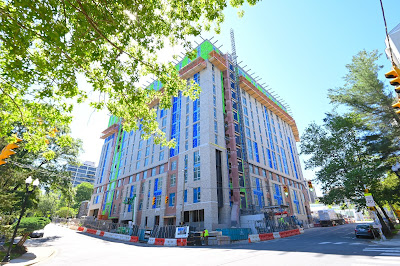
Late last year, the Views at Clarendon
emerged unscathed from a cloud of lawsuits and officially kicked off construction. Now one of the region's more intriguing mixed-use projects is on schedule, and attracting national attention as a model for unique partnerships. The
Views at Clarendon Corporation's mixed-use, mixed-income building will hold 70 affordable apartments and 46 market rate apartments, not so outstanding by itself, but that it was done through the auspices of the church is turning the heads of urban planners around the country.
As the First Baptist Church of Clarendon faced a

budget shortfall a decade ago, it could have reacted in the typical fashion, selling out to a developer and moving to a cheaper, less urbanized community. That would have shut down the church's daycare center and local mission. Instead, the church chose to protect its historic building, stay local, keep the daycare center and double down on its mission by setting up a non-profit corporation to run an affordable housing project. First Baptist - now the
Church at Clarendon - sold its air rights to the non-profit, of which it held 3 of 7 board seats, allowing the non-profit to cater to low-income and disabled residents, consistent with the church mission. Other urban churches have retained a portion of the new structure after selling its land, but the model of expanding its influence is a new one. Architect
Michael Foster, a principal of Arlington's
MTFA Architecture, thinks of this as a paradigm shift. "This has really been watched closely, and nationally, for mixing an existing church at the base of the building in this way. Most mixed-use is office-retail-residential. One that's dominated by public housing is not totally unprecedented, but as a land-use model, it helps us all think a little differently about preserving the role of churches and communities."

Not all the attention has been positive. Local groups tried to stop the in-fill project, then protested that Arlington's subsidies for the new non-profit Views at Clarendon constituted an Establishment Clause violation, and the organization found themselves twice in the chambers of the Virginia Supreme Court and several times the subject of
Washington Post news fodder. Vindicated by the courts, the non-profit has now nearly finished excavating the site and underpinning the church, and expects to start building up by next month. The church "sandwich" will give them two floors as a condominium and a 3-floor building on the side, the non-profit will own the apartments above and the parking garage below.
Of the 70 affordable apartments, the majority will be priced at 60% AMI, six of the apartments will be 100% accessible (visitable and adaptable), 12 units will have "support of services" provided to those with disabilities, and six of them will be offered to families under 50% AMI. The church will continue to operate the 180-child daycare center, Arlington's largest, as well as expanding its urban ministry, all within a block of Metro. Foster, the project architect, thinks this will help churches remain active in the social fabric, and that the importance of this should not be underestimated. "This represents a dramatic change in how the church engages the community," and that planning organizations are taking note. "We've been getting many calls about this" says Foster, whose firm is also working on a
similar type of project in Bethesda, with the church as developer rather than outgoing owner. The non-profit Views has hired
Arlington Partnership for Affordable Housing (APAH) as a consultant to help them achieve their affordable housing vision.
The old steeple will remain the tallest structure, with the new building rising just below the steeple height by design. Foster says the building is meant to adapt a mid-rise to colonial architectural style. "The base of the building is designed to fit in with the colonial heritage with the church steeple and remaining school. Its not really meant to be pure colonial, and not meant to be neoclassical, but it does represent what remains on site and the compatibility with the adjacent neighborhood."
Arlington, VA Real Estate Development News







































 "We're just waiting for our electricity to be rewired and then we can get
"We're just waiting for our electricity to be rewired and then we can get 











